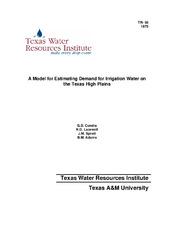| dc.description.abstract | With rapidly changing conditions in production agriculture, the need for highly flexible and quickly applicable methods of analysis is emphasized. The purpose of this study was to develop such a model for a homogeneous production region in the Texas High Plains.
A linear programming model was constructed whereby crop or input prices are readily adjustable. In addition, limitations on quantities of inputs available can easily be evaluated. The model contains cotton, grain sorghum, corn, wheat and soybeans. Inputs that can be evaluated include irrigation water, natural gas, diesel, nitrogen fertilizer and herbicides. The primary focus of this work was to estimate the demand for irrigation water in the study area.
The model was applied using alternative crop prices and input prices. Assuming average crop prices, current input prices and only variable costs of production, as the price of water was increased wheat shifted from irrigated to dryland production, then grain sorghum, cotton, corn and soybeans, in that order. The price of water was $71.75 per acre foot plus current pumping cost when all land shifted to dryland production.
The same analysis, except variable and fixed costs both included, gave similar results relative to the sequence of crops that shift to dryland production as the price of water was increased. However, the shifts occurred at much lower water prices; i.e., at $24.47 per acre foot plus current pumping costs, all land had shifted to dryland production. This suggests that over the long run, irrigation in the Texas High Plains is quite sensitive to the price of energy used in pumping water. Further, there are strong implications relative to farmer's "ability to pay" for water imported to the High Plains from other regions.
In this report, several scenarios including low, high and average crop prices and average and high input prices were evaluated. | en |


